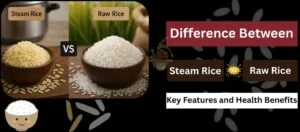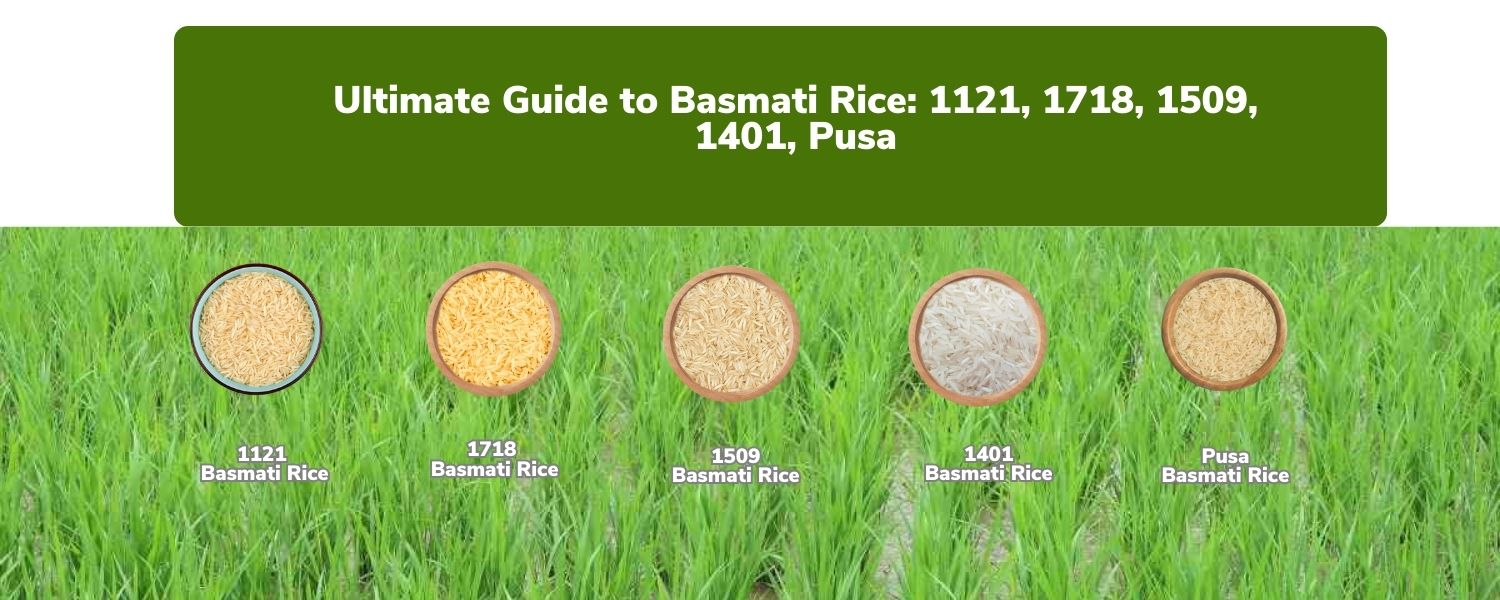Basmati rice, the ultimate fragrance and elongated and slender rice, is a favorite item for kitchen experts in a number of culinary traditions. Each type of Basmati rice has unique characteristics that can significantly impact the texture and flavor of your dishes. In this blog, we will deal with the most popular Basmati rice varieties: 1121, 1718, 1509, 1401, and Pusa. Thus, getting to know these varieties will help you to make the best decision on the use of the respective type in your kitchen.

1. 1121 Basmati Rice
What It Is: Basically, to say, 1121 Basmati Rice is the type of rice with very extended grains and the best features of cooking. This is a hybrid type that gained favor for its characteristic of never becoming soggy and muddled.
Characteristics:
Grain Length: A fair but substantial length of the grain is showcased as it is cooked which may even reach 8.4 mm.
Texture: Not very soft and sticky too, on the contrary, it is fluffier.
Aroma: Light and fulfilling.
Key Features:
Appearance: The rice with the longest grains looks great on the dish, especially for those gems where the presentation counts equally as taste.
Cooking Quality: The rice comes with a fluffier texture that allows the chef to cook biryanis and pilafs which will not stick to each other i.e. grains will remain separate from the others.
Flavour: Lightly nutty, a fitting companion to various flavours.
Best For:
Festive Dishes: It is the best option for such events, when the food is luxurious, and the grain-like quality of this type of rice is excellent.
Gourmet Recipes: One of the top products that satisfy the culinary skill required plus a food appearance that fits well with the high-grade food categories out of these, the sensory fun one is the most important

2. 1718 Basmati Rice
What It Is: Therefore, one can assume 1718 Basmati rice is the best product variety of an import corporation and the leader of a public enterprise. Another crossed kind of the Basmati is a dryland combination of the consistent Basmati and first-grade agronomic.
Characteristics:
Grain Length: The grains are long, slender, and firm.
Texture: It’s soft and loose.
Aroma: Pungent which means that it has a very strong and pleasant smell.
Key Features:
Appearance: It is a balmy light brown color, a variety of visual taste that is rich in the human brain if not of the eye.
Cooking Quality: The thing that comes out of this is some rice with equal distance between the grains. The grains are very dry and will softly dummy-up. You may find good use of them with the tincture meal rice or anything else you like.
Flavour: The aroma that gives a mouthwatering flavor not only to people but also to animals.
Best For:
Festive Dishes: It’s also taken care of by the possible substitution of an alternative station and the homogeneously “normal” everyday food for that matter. It’s excellent in the way it is presented in biryani, pilaf is best.

3. 1509 Basmati Rice
What It Is: 1509 Basmati rice is an esteemed long grain variety that is characterized by excellent grain length and yield. For 1509 rice, free from insects and mold is the most important cost driver. It is a variety that is difficult to grow, and therefore, has a limited supply in the market. It is a premium type that allows for higher cooking capabilities and is more pleasurable than other sorts of the food.
Characteristics:
Grain Length: Extra-long, up to 8.2mm when cooked.Texture: Fluffy and non-sticky.Aroma: Strong fragrant odor that comes from a flower.
Texture: Fluffy and non-sticky.
Aroma: Strong fragrant odor that comes from a flower.
Key Features:
Appearance: Extra-long grains are, in essence, just a fantasy for rice that can be seen through the children’s tales.
Cooking Quality: Fluffy, and goes with many different dishes, the dressing of the same and it is perfect for many societies for which it is an important part.
Flavour: Resourceful, it is often used as a flavor enhancer of any other one.
Best For:
Festive Dishes: In the hospitality industry, this type is not least, but mostly, rice is farmed and distributed to special venues where its uptake is highest and hence the consumption level goes with the quality.Gourmet.
Cooking: The high-class food that is specific to the global economies, and requires high-flavored and nicely-presented food.

4. 1401 Basmati Rice
What It Is: This rice is a traditional 1401 Basmati variety that is widely known for the long grains and the quality of the grain that is kept on the same level. 1401 basmati rice has long been a bright spot in rice production. This type of rice is the popular variety among those who are after a combination of a working model of an appliance and a good flavor lease.
Characteristics:
Grain Length: Long
Texture: Fluffy with a little bit stickiness
Aroma: Aroma: Mild and Spicy.
Key Features:
Appearance: The grains are long without a dramatic contrast to others, but they are also nevertheless attractive.
Cooking Quality: The lesser generations came in maintaining the rice as most were overcooked not knowing proper cooking methods leading to over-sticky rice in 1401 and lesser resistance against chewing.
Flavour: The uses of this rice are barreled and therefore are suitable for a range of recipes.
Best For:
Regular Use: Ideal for everyday cooking and recipes where a slightly stickier texture is acceptable.
Traditional Dishes: Works well in traditional dishes and family meals.

5. Pusa Basmati Rice
What It Is: Pusa Basmati rice is a hybrid variety produced by Pusa Basmati Agricultural Research Institute in India for the Indian Agricultural Research Institute. It’s recognized for its long grains and consistent quality.
Characteristics:
Grain Length: Long
Texture: Fluffy with less stickiness
Aroma: Strong and pleasant.
Key Features:
Appearance: Long grains that are consistent and reliable, making it a favorite for many households.
Cooking Quality: Cooks up fluffy and separate, suitable for a variety of dishes.
Flavour: Robust and flavorful, enhancing the taste of your meals.
Best For:
Regular Use: Suitable for a wide range of recipes, from everyday meals to special dishes.
Cost-Effective: Offers good quality at a relatively lower cost compared to premium varieties.
Conclusion
Choosing the right Basmati rice variety can make a significant difference in your culinary creations. Whether you opt for the extra-long grains of 1121 Basmati, the high yield of 1718, the premium quality of 1509, the reliable performance of 1401, or the robust flavor of Pusa Basmati, each variety offers unique benefits. By understanding the characteristics of each type, you can select the best rice for your recipes and enjoy the rich flavors and textures that Basmati rice has to offer.
Related Posts
1718 Golden Sella Basmati Rice
1718 Golden Sella Basmati Rice is one of the most premium varieties of rice widely admired for its aromatic essence and its quality of preventing

Difference Between Steam Rice vs Raw Rice: Which is Good for Health
For centuries, rice has been the most important part of Indian meal. Whether it is a festival or a mundane day, rice delicacies like Biryani,
1718 Sella Basmati Rice
1718 Sella Basmati Rice is a premium long-grain variety popular for its slender shape and distinct aroma. This rice undergoes a unique process of parboiling

